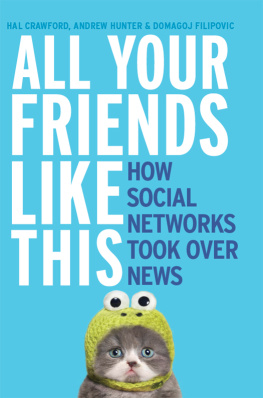Going Viral
To all of those dedicated to an open Internet
Copyright Karine Nahon and Jeff Hemsley 2013
The right of Karine Nahon and Jeff Hemsley to be identified as Authors of this Work has been asserted in accordance with the UK Copyright, Designs and Patents Act 1988.
First published in 2013 by Polity Press
Polity Press
65 Bridge Street
Cambridge CB2 1UR, UK
Polity Press
350 Main Street
Malden, MA 02148, USA
All rights reserved. Except for the quotation of short passages for the purpose of criticism and review, no part of this publication may be reproduced, stored in a retrieval system, or transmitted, in any form or by any means, electronic, mechanical, photocopying, recording or otherwise, without the prior permission of the publisher.
ISBN: 978-0-7456-7548-0
A catalogue record for this book is available from the British Library.
The publisher has used its best endeavours to ensure that the URLs for external websites referred to in this book are correct and active at the time of going to press. However, the publisher has no responsibility for the websites and can make no guarantee that a site will remain live or that the content is or will remain appropriate.
Every effort has been made to trace all copyright holders, but if any have been inadvertently overlooked the publisher will be pleased to include any necessary credits in any subsequent reprint or edition.
For further information on Polity, visit our website: www.politybooks.com
Contens
Figures and Tables
Figures
Tables
Acknowledgments
There is so much more to a book than just the writing of it. As such, we are indebted to a large number of people, who answered our questions, shared their data with us, provided some of the graphics for the book, debated with us, and helped us crystalize ideas and concepts or just contributed their time. A special thanks to Gilad Lotan of SocialFlow, who provided us data and graphics related to the viral spread of the news of Osama bin Ladens death and the video of KONY2012; Miguel Rios from Twitter allowed us to use his graphic of Twitter volume regarding Osama bin Ladens death; Simon Rogers of the Guardian and Alon Halevi at Google assisted us with the WikiLeaks case; Daphne Koller answered our questions about Coursera; Sarah Wachter graciously allowed us to analyze her YouTube referral data of Librarians Do Gaga and Jacques Hebert at MotherJones blog also shared data with us regarding the video of Mitt Romney talking about 47 percent of Americans; Tal Gallili answered questions and shared data related the R-Bloggers website; and Alex Constant helped us gather and interpret materials about the Rosa Parks case. Elliott Karstadt, Jennifer Jahn, and Neil de Cort at Polity Press worked behind the scenes on Going Viral and guided us through the publishing process. Arlene Pritzker, Elia Finkelstein, and Melody Lutz all assisted with language edits and feedback, and the anonymous readers provided thoughtful feedback that greatly improved the quality of the text. We thank all of you.
Another category of people who deserve our heartfelt thanks are members of our research teams, colleagues, and mentors whose efforts and input made this work possible. From the retroV research team (supported by a Google Research Award) we thank Muzammil Hussain, Chris Wells, Lance Bennett, and particularly Shawn Walker, whose legendary skill with collecting and stitching together complex data sets are at the heart of a growing list of research projects. Thank you to our colleagues at the Social Media Lab (SoMe Lab, funded by the National Science Foundation), made up of Robert Mason (the Million Dollar Man), Josef Eckert (GeoJoe), and again Shawn Walker (Data Daddy), for their patience, support, input, and assistance, as well as their work on the SoMe Tools project, out of which came the data used in the UC Davis pepper spray case. Further, Jeff thanks Robert Mason for support and guidance, Kirsten Foot for hard questions, and Malcolm Parks for giving virality a chance. Karine thanks Manuel Castells and the members of the working group at the Library of Congress, where the seed for this book was planted, and both of us extend our gratitude to John Thompson for his insistence that we nurture that seed and patience in walking us through the process of writing a book.
Finally, and most importantly, we thank our spouses, Arlene and Michael, Karines kids (Daniel and Ari) and mother (Ody) for encouraging, understanding, supporting, and enduring our esoteric rants on the topic of virality.
Preface
The idea for this book came about while I was visiting the Library of Congress (LOC) in Washington, DC. For me, LOC is one of the temples of culture of societies. I came to Washington on the invitation of my colleague and friend Manuel Castells, who was participating in a one-week working group about the role of the Library of Congress over the next 25 years. The growing use of social media and the explosion of user-generated content create new challenges and opportunities for libraries. One of the most pressing questions for libraries is what should libraries attempt to collect and curate in this new media environment, given the ease of creating and sharing content, the tremendous and growing volume of this content, as well as the infeasibility of libraries collecting and saving it all. This is where virality comes in. While there, I gave a talk about virality and its impact on society.
My colleagues and I from the retroV research group at the University of Washingtons Information School had been researching virality extensively for four years, particularly what it means for society. In the meeting at LOC, I argued that viral information is one indicator of what is important to a particular society at a particular moment. I suggested that as libraries struggle to decide what to curate, a good starting point would be to consider information items that have gone viral. This is because viral events arise out of the complex interactions of many actors individuals, companies, governments as well as the social and cultural contexts within which they are embedded. Virality can signal what is considered important and interesting to parts of a society at a particular time, and traces of viral content may also become a way of documenting the fabric of societies. As such, future generations may find the viral events of today valuable lenses into our time, providing insights that we ourselves will miss because of our own embeddedness in the world from which these viral events arise.
Social media makes it very easy to digitally express ourselves and share that expression instantly. It enables some social activity to happen faster and reach farther out into the networks that connect us all. Part of what makes this social infrastructure so interesting is that it is made up of vast interconnected crowds all doing their own thing. Except, sometimes they come together. Sometimes the crowd finds some bit of content remarkable. In fact, they find it so remarkable that within a few days they remark on it, and share it will all of their friends and followers. In a way, a viral event is the collective voice of the crowd saying this is important! Whether its a middle-aged Scottish vocalist who makes us challenge our stereotypes, a humorous protest video that creates a public relations nightmare for a major airline, or an uplifting news story of a flash mob where musicians played the Beatles tune Here Comes the Sun in a busy Spanish unemployment office, viral events are the remarkable bits of culture that rise to the top. Once there, they can quickly focus the publics attention on police brutality against peaceful protestors, the personal infidelity of high-ranking officials, or the suffering of communities after natural disasters.













